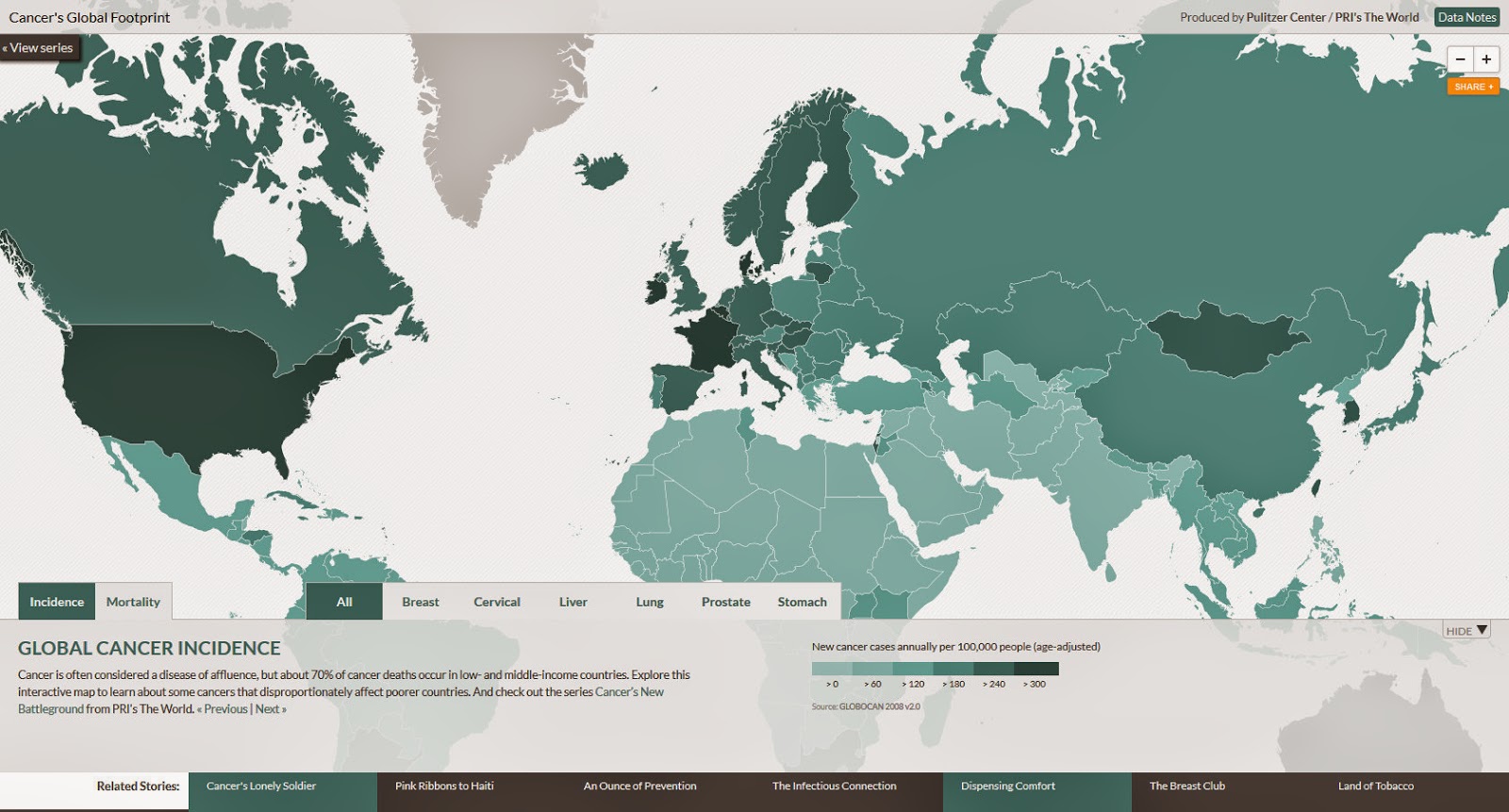Cancer’s Global Footprint Mapped
Cancer is often considered a disease of affluence, but about 70 percent of cancer deaths happen in low- and middle-income countries.
Below is the interactive map of Cancer’s Global Footprint produced by the Pulitzer Center.

Cancer is a leading reason of death in numerous rich nations, and its deaths are rising in more impoverished regions. A 2012 study in The Lancet Oncology prognosticated that from 2008 to 2030, cancer occurrence will increase 75% worldwide and will double in the least developed nations.
Breast cancer is the world’s most prevalent cancer in women. The sickness is diagnosed most often in developed nations. Proper nutrition in childhood and a comparatively late age at which women begin childbearing are likely factors. The high rate of disease in prosperous countries may also reflect aggressive screening.
Although breast cancer is diagnosed more regularly in wealthy countries, some low-income states – in Africa, Latin America, and the Caribbean – experience very high death rates. The absence of early detection programs in these nations may play a role. Genetics may also be a factor; women of African origin tend to develop more aggressive cysts than women of European descent.
Rates of cervical cancer are once the leading cause of cancer death for women in the U.S. – have fallen in North America and abroad in the developed world. A significant reason is the Pap test, which can recognize precancerous tumors. In low-income nations, testing is rare, and the disease remains prevalent and deadly.
The leading cause of cervical cancer is human papillomavirus, and a common sexually spread disease. Vaccines against papillomavirus and low-cost analyses that detect precancerous tumors could dramatically lower death rates in nations where the disease yet kills vast amounts of women.
About 85 percent of liver cancer cases happen in developing countries. In Asian nations such as Mongolia, the burden of disease is blamed on high rates of hepatitis B and C and widespread alcohol use. In West Africa, a relevant factor is an exposure to aflatoxins, carcinogenic compounds that can poison peanuts and other crops.
In countries with high rates of liver cancer, people tend to contract the disease – and die from it – at an unusually young age. In some high-risk nations, childhood immunization programs against hepatitis B have been implemented. Such a treatment program in Taiwan started in 1984 seems to have decreased liver cancer rates amongst young adults.
Lung cancer kills more people worldwide than any other cancer, and by far, the most significant cause of the disease is cigarettes. The lag time within when a human begins smoking and when cancer develops can be thirty years. High rates of lung cancer in nations such as the U.S. indicate high smoking rates many decades ago.
Smoking has decreased in many industrialized nations, but it is rising in developing countries. Today, China consumes more than a 3rd of the world’s cigarettes, and approximately two-thirds of men in Indonesia smoke. Specialists predict sharp gains in lung cancer deaths in developing countries in the years ahead.
Prostate cancer is the 2nd most frequent cancer of men globally. The disease is diagnosed most commonly in high-income countries. One reason is aggressive screening with the prostate-specific antigen test. Testing can find cancer early when it is treatable but may also identify cysts that would never pose a risk to a man’s life.
Some nations in sub-Saharan Africa and other countries with large black populations have high death rates from prostate cancer. Men of African origin are susceptible to the disease. In the U.S., Blacks men are more than twice as likely to die from prostate cancer as white men.
Rates of stomach cancer – the 4th most common cancer disease worldwide – vary dramatically within nations and between them. Prevalence is unusually high in East Asia, where diets rich in salty and pickled foods are a risk factor. Infection with the bacterium H. pylori, especially prevalent in developing nations, is also recognized as a significant cause of stomach cancer.
Stomach cancer was once the leading cause of cancer death in the U.S. today, and it doesn’t make the top ten. This drop may be due in part to the appearance of refrigeration, which has decreased the use of salt as a food preservative. Japan, where stomach cancer is widespread, conducts mass screenings to detect the illness early.








